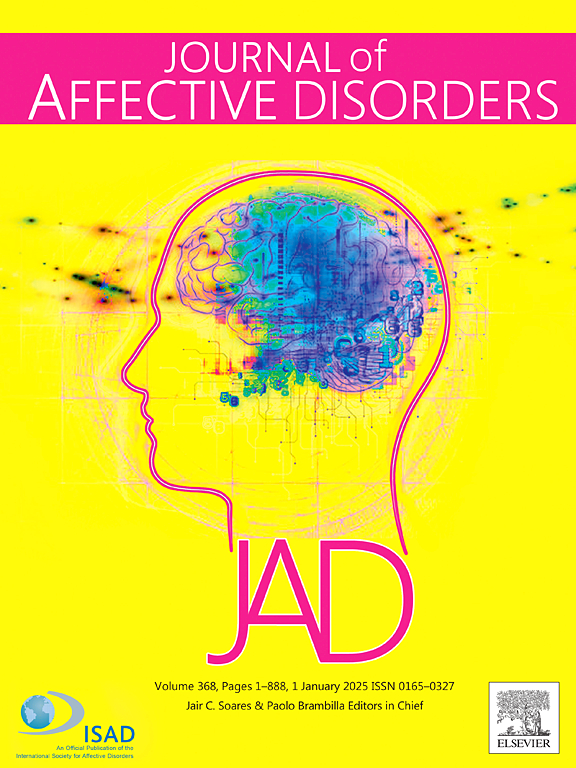The association of sex and age of treatment-resistant tendency to antidepressants: A cohort study of 325,615 patients with major depressive disorder
IF 4.9
2区 医学
Q1 CLINICAL NEUROLOGY
引用次数: 0
Abstract
Background
Treatment resistance to antidepressants can impose a significant burden on patients with major depressive disorder (MDD). This study aimed to evaluate the effects of age, sex, and psychiatric and physical comorbidities on the tendency toward treatment resistance to antidepressants (TRT).
Methods
We utilized data from the Taiwan National Health Insurance Research Database. Patients diagnosed with MDD were included in the study. Physical comorbidities were assessed using the Charlson Comorbidity Index. TRT was defined as receiving antidepressant treatment at an adequate defined daily dose, followed by a subsequent switch to another antidepressant within one year after the initial diagnosis of depression. Logistic regression was used to estimate the odds ratios (ORs) of various potential factors associated with TRT.
Results
A total of 325,615 patients with MDD were included in the study. After adjusting for key confounders, patients aged 20 to 29 years had the highest OR (1.60; 95 % confidence interval [CI]: 1.50–1.70) for TRT compared to the oldest age group (≥80 years). The ORs gradually decreased with increasing age. Males had a significantly lower OR (0.89; 95 % CI: 0.88–0.91) for TRT than females. TRT was also associated with the presence of physical and psychiatric comorbidities, except for autism spectrum disorder (ASD).
Limitations
As a naturalistic observational study, our findings are subject to potential confounding factors that cannot be fully controlled for, as would be possible in a formal randomized controlled trial.
Conclusions
Our study highlights the impact of age and sex on TRT. Clinicians should consider these risk factors when managing patients with MDD.
性别和年龄与抗抑郁药物治疗抵抗倾向的关系:一项对325,615例重度抑郁症患者的队列研究
背景:抗抑郁药物的治疗耐药性对重度抑郁症(MDD)患者来说是一个巨大的负担。本研究旨在评估年龄、性别、精神和身体合并症对抗抑郁药治疗抵抗(TRT)倾向的影响。方法采用台湾全民健康保险研究数据库资料。诊断为重度抑郁症的患者也被纳入研究。使用Charlson合并症指数评估身体合并症。TRT被定义为接受适当的每日剂量的抗抑郁药物治疗,随后在最初诊断为抑郁症后一年内切换到另一种抗抑郁药物。采用Logistic回归估计与TRT相关的各种潜在因素的比值比(ORs)。结果共纳入325,615例重度抑郁症患者。在调整关键混杂因素后,20 - 29岁的患者OR最高(1.60;95%可信区间[CI]: 1.50-1.70)与年龄最大的年龄组(≥80岁)相比。随着年龄的增长,ORs逐渐降低。男性OR显著降低(0.89;95% CI: 0.88-0.91)。除了自闭症谱系障碍(ASD)外,TRT还与身体和精神合并症的存在有关。局限性:作为一项自然观察性研究,我们的研究结果受到无法完全控制的潜在混杂因素的影响,这在正式的随机对照试验中是可能的。结论我们的研究强调了年龄和性别对TRT的影响。临床医生在管理重度抑郁症患者时应考虑这些风险因素。
本文章由计算机程序翻译,如有差异,请以英文原文为准。
求助全文
约1分钟内获得全文
求助全文
来源期刊

Journal of affective disorders
医学-精神病学
CiteScore
10.90
自引率
6.10%
发文量
1319
审稿时长
9.3 weeks
期刊介绍:
The Journal of Affective Disorders publishes papers concerned with affective disorders in the widest sense: depression, mania, mood spectrum, emotions and personality, anxiety and stress. It is interdisciplinary and aims to bring together different approaches for a diverse readership. Top quality papers will be accepted dealing with any aspect of affective disorders, including neuroimaging, cognitive neurosciences, genetics, molecular biology, experimental and clinical neurosciences, pharmacology, neuroimmunoendocrinology, intervention and treatment trials.
 求助内容:
求助内容: 应助结果提醒方式:
应助结果提醒方式:


